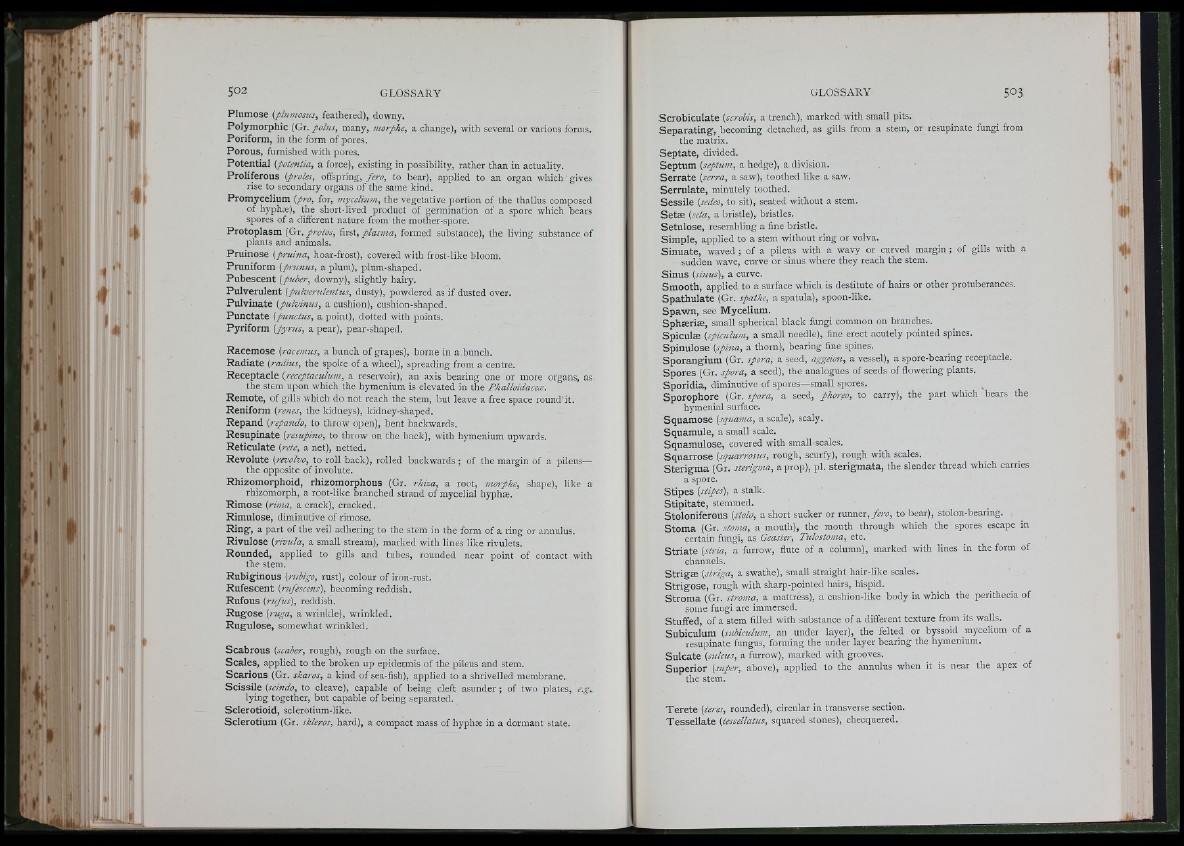
'V r-
V . , : p i :
I * . :
t^S -é:
I * : , t; :!
k ' ’ '
^■f;:
'il
H /
'ï ft
:U
I-,
■l' I
c
. 9 I* i
I
I r
ñ
I '* '.
r
h \ I ,ri'l,. "
iri'!
S 0 2 GLOSSARY
Plumose {phcniQsiís, feathered), downy.
Polymorphic (Gr. polus, many, tttorphe, a change), with several or various forms.
Poriform, in the form of pores.
Porous, furnished with pores.
Potential (potentia, a force), existing in possibility, rather than in actuality.
Proliferous (proles, offspring, fero, to bear), applied to an organ which ' gives
rise to secondary organs of the same kind.
Promycelium (pro, for, mycelium, the vegetative portion of the thallus composed
of hyphæ), the short-lived product of germination of a spore which bears
spores of a different nature from the mother-spore.
Protoplasm (<Gx.protos, iix%\., plasma, formed substance), the living substance of
plants and animals.
Pruinose (pruina, hoar-frost), covered with frost-like bloom.
Pruniform (prunus, a plum), plum-shaped.
Pubescent (puber, downy), slightly hairy.
Pulverulent (pulverulentus, dusty), powdered as if dusted over.
Pulvinate (pulvinus, a cushion), cushion-shaped.
Punctate (pumius, a point), dotted with points.
Pyriform (pyrus, a pear), pear-shaped.
Racemose (racemus, a bunch of grapes), borne in a bunch.
Radiate (radius, the spoke of a wheel), spreading from a centre.
Receptacle (receptaculum, a reservoir), an axis bearing one or more organs, as
the stem upon which the hymemum is elevated in the Phalloidaceæ.
Remote, of gills which do not reach the stem, but leave a free space round'it.
Reniform (renes, the kidneys), kidney-shaped.
Repand (repando, to throw open), bent backwards.
Resupinate (resupino, to throw on the back), with hymenium upwards.
Reticulate (rete, a net), netted.
Revolute (revolvo, to roll back), rolled backwards ; of the margin of a pileus—
the opposite of involute.
Rhizomorphoid, rhizomorphous (Gr. rhiza, a root, morphe, shape), like a
rhizomorph, a root-like branched strand of mycelial hyphæ.
Rimóse (rima, a crack), cracked.
Rimulose, diminutive of rimóse.
Ring, a part of the veil adhering to the stem in the form of a ring or annulus.
Rivulose (rivula, a small stream), marked with lines like rivulets.
Rounded, applied to gills and tubes, rounded near point of contact with
the stem.
Rubiginous (rubigo, rust), colour of iron-rust.
Rufescent (rufescens), becoming reddish.
Rufous (n fu s ), reddish.
Rugose (ruga, a wrinkle), wrinkled.
Rugulose, somewhat wrinkled.
Scabrous (scaber, rough), rough on the surface.
Scales, applied to the broken up epidermis of the pileus and stem.
Scarious (Gr. skaros, a kind of sea-fish), applied to a shrivelled membrane.
Scissile (scindo, to cleave), capable of being cleft asunder ; of two plates, e.g.
lying together, but capable of being separated.
Sclerotioid, sclerotium-like.
Sclerotium (Gr. skleros, hard), a compact mass of hyphæ in a dormant state.
GLOSSARY SO3
Scrobiculate (scrobis, a trench), marked with small pits.
Separating, becoming detached, as gills from a stem, or resupinate fungi from
the matrix.
Septate, divided.
Septum (septum, a hedge), a division.
Serrate (serra, a saw), toothed like a saw.
Serrulate, minutely toothed.
Sessile (sedeo, to sit), seated without a stem.
Setæ (seta, a bristle), bristles.
Setulose, resembling a fine bristle.
Simple, applied to a stem without ring or volva.
Sinuate, waved ; of a pileus with a wavy or curved margin ; of gills with a
sudden wave, curve or sinus where they reach the stem.
Sinus (sinus), a curve.
Smooth, applied to a surface which is destitute of hairs or other protuberances.
Spathulate (Gr. spathe, a spatula), spoon-like.
Spawn, see Mycelium.
Sphæriæ, small spherical black fungi common on branches.
Spiculæ (spiculum, a small needle), fine erect acutely pointed spines.
Spinulose (spina, a thorn), bearing fine spines.
Sporangium (Gr. spora, a seed, aggeion, a vessel), a spore-bearing receptacle.
Spores (Gr. spora, a seed), the analogues of seeds of flowering plants.
Sporidia, diminutive of spores—small spores.
Sporophore (Gr. spora, a seed, phoreo, to carry), the part which bears the
hymenial surface.
Squamose (squama, a scale), scaly.
Squamule, a small scale.
Squamulose, covered with small- scales.
Squarrose (squarrosus, rough, scurfy), rough with scales.
Sterigma (Gr. sterigma, a prop), pi. sterigmata, the slender thread which carries
a spore.
Stipes (stipes), a stalk.
Stipitate, stemmed.
Stoloniferous (stolo, a short sucker or runner,/«-», to bear), stolon-bearing.
Stoma (Gr. stoma, a mouth), the mouth through which the spores escape in
certain fungi, as Geastei', Tulostoma, etc.
Striate (stria, a furrow, flute of a column), marked with lines in the form of
channels.
Strigæ (striga, a swathe), small straight hair-like scales.
Strigose, rough with sharp-pointed hairs, hispid.
Stroma (Gr. stroma, a mattress), a cushion-like body in which the perithecia of
some fungi are immersed.
Stuffed, of a stem filled with substance of a different texture from its walls.
Subiculum (subiculum, an under layer), the felted or byssoid mycelium of a
resupinate fungus, forming the under layer bearing the hymenium.
Sulcate (sulcus, a furrow), marked with grooves.
Superior (super, above), applied to the annulus when it is near the apex of
the stem.
Terete (teres, rounded), circular in transverse section.
Tessellate (tessellatus, squared stones), checquered.
T
f